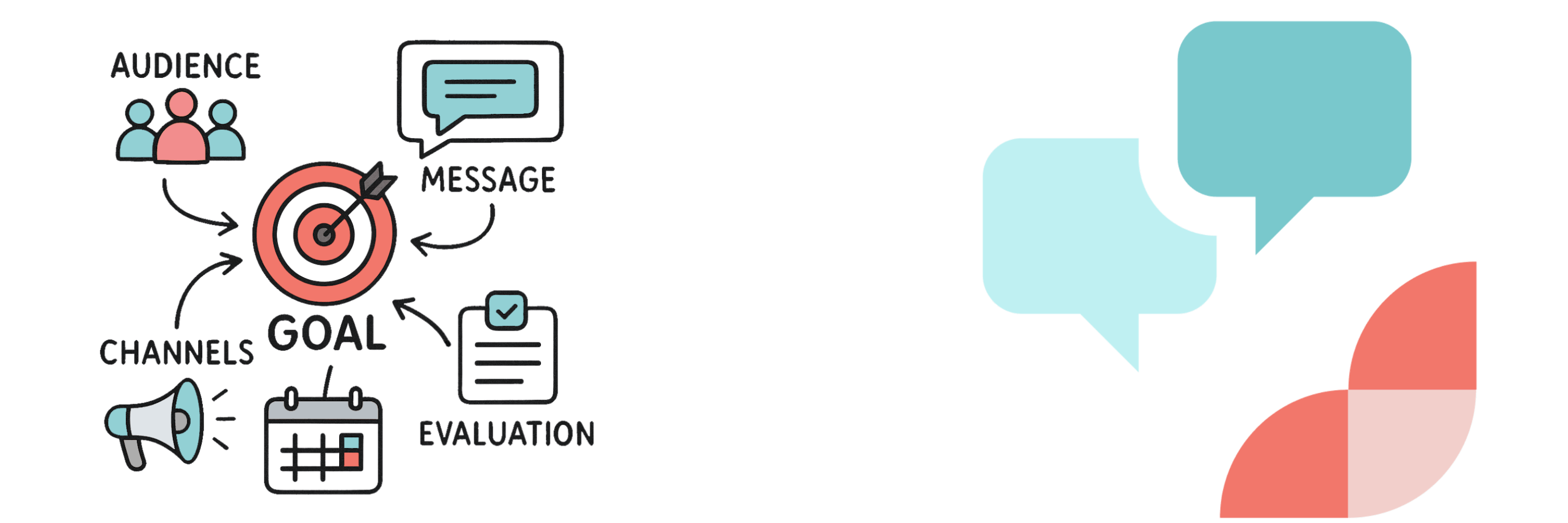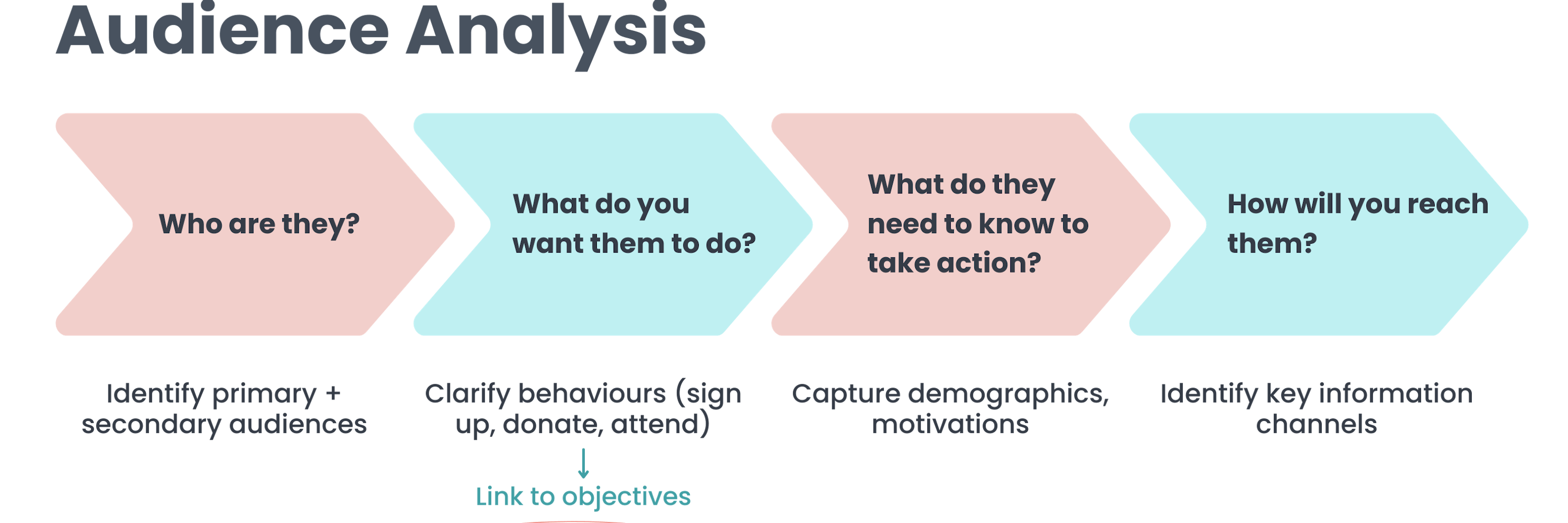A Step-by-Step Guide for Teams with Limited Resources
I spent years working in nonprofit and donor-funded teams. We love strategies. We love programme objectives, monitoring and evaluation plans, pause-and-reflect sessions, project roadmaps, and performance indicator reference sheets. We're great at this stuff when it comes to implementation, but why do so many nonprofits and donor-funded programmes skip developing their own communications strategies?

Why don't more nonprofits have communications strategies?
Often, as the reasoning goes, limited resources are better spent on other tasks. After all, communicating is the easy part. Or you may hear, "young people are good at technology and social media, so let's assign a junior staff member to make some posts once in a while".
Stop right there! Let's talk about these pitfalls.
Sure, junior stuff (i.e. "young people") are arguably more tuned in to the latest social media trends than we older millennials could ever hope to be in 2025. That's great – knowing how to use today's popular digital platforms is important! But skill is not strategy, and skill alone won't help your team achieve your impact.
Yes, resources are scarce, but in reality a limited budget makes having a strategy even more essential. Without it, teams risk scattering their energy across one-off campaigns, ad hoc social media posts, or donor updates that never quite connect. Effective communications strategies ensure that every message serves a purpose, content amplifies the impact, and scarce resources stretch further.
And yes, it's true that an effective strategy requires some time, but it doesn’t require a glossy document or a whole new team. It’s about clarity – knowing who you need to reach, what you want them to do, and how best to engage them with the resources you have.
This quick guide is meant to help nonprofits, donor-funded projects, and other resource-strapped teams turn their missions into messages that mobilise supporters, attract funding, and strengthen trust with the communities they serve, while avoiding wasted time and funding.

Elements of a nonprofit communications strategy
Let's break it down into seven key elements. Get these right and you'll be well on your way to building an effective communications strategy.
1. Mission and Objectives
What do you want communications to achieve? For nonprofits, that might mean raising awareness of an issue, increasing donations, recruiting volunteers, or influencing policy. Objectives should tie directly to the organisation’s mission, with measurable indicators to track progress.
2. Key Audiences and Desired Behaviours
Knowing who you’re speaking to and why is the foundation of any effective communications strategy. Nonprofits often think of “the public” as their audience, but in reality, you’ll achieve far more impact by narrowing your focus to the specific groups of people who can help you advance your mission.
3. Messages
What messages will you use to make your audiences understand and act? Good messaging strikes a balance between clarity and emotion. It communicates your mission in ways that are accessible, compelling, and consistent.
4. Channels and Tools
Where and how will you share your messages? This could include social media, newsletters, websites, events, traditional media, or one-on-one outreach. The key is to select the channels your audiences actually use, not just the ones that are easiest for you to manage.
5. Roles and Responsibilities
Even in small teams, clarity about who does what is critical. A strategy should assign ownership — who drafts content, who approves, who manages social media, who liaises with media — so tasks don’t fall through the cracks.
6. Timeline and Budget
Outline how much you will spend, what resources you need, and the timeline for campaigns or activities. This ensures your plan is realistic and achievable.
7. Evaluation
How will you know if your communications are working? Set indicators for success (like number of new donors, event attendance, policy mentions, or engagement rates) and schedule regular check-ins to review and adjust.

Step-by-step process for building a communications strategy
Step 1: Clarify your mission and objectives
Start with your nonprofit’s broader goals. Identify where communications can make the biggest difference. For example, if your priority this year is to increase local donations, your communications should focus on building relationships with community supporters rather than launching a broad awareness campaign.
Define key communications objectives that advance your organisation's mission. For nonprofits and donor-funded teams, this should sound familiar – think of it like a Logframe exercise.
Step 2: Define your audiences and what you want them to do
List your primary and secondary audiences. Use simple profiles to capture their demographics, needs, motivations, and information sources. Think in terms of real people – not just categories.
Once you’ve defined these audiences, go a step further by clarifying the behaviours you want from them. Awareness is valuable, but it’s not enough on its own. Communications are most effective when they’re tied to action. For example, instead of broadly “raising awareness about mental health”, a nonprofit hotline might want to encourage at-risk young people to use its anonymous chat feature.

Step 3: Craft your key messages
Key messages are the backbone of your communications, but they only become powerful when they’re crafted with two things in mind: the audiences you’re trying to reach and the objectives you want to achieve.
Start by going back to your audiences and desired behaviours. For each group, ask yourself:
- What do we want this audience to do?
- What do they need to hear from us to take that step?
When done well, this alignment prevents messages from becoming generic slogans. Instead, each one becomes a targeted tool to move an audience closer to the behaviour your organisation needs to see.
Step 4: Choose your channels
The most effective communications strategies don’t try to be everywhere at once. Instead, they focus on the channels that reach the right audiences in the most cost-effective way.
Start with your audience profiles. Where do they already spend their time? Donors may respond well to personalised email updates. Young people might engage more on social media or messenger apps. Policymakers might be best reached through targeted briefings, op-eds, or LinkedIn. By matching each audience to the channels they actually use, you increase the likelihood that your messages will be seen and acted upon.
Step 5: Assign responsibilities
Write down who is responsible for each activity, even if it’s just one person. This keeps accountability clear and prevents tasks from being overlooked or duplicated.
Step 6: Plan your activities
Create a calendar with your planned campaigns, events, and content. Link each activity back to your objectives and audiences. This ensures you’re not producing content just for the sake of it. Linking to your objectives will also help your monitor your progress.
Create a plan for each month to set goals and identify key events and themes. Turn your monthly plan into a content calendar so you can plan the drafting and dissemination of your materials in advance. This promotes consistency, accountability, and more effective monitoring.
Step 7: Set metrics and review regularly
A strategy is only as strong as its ability to show results. To know whether your communications are working, you need to define clear metrics and track them consistently. But not all numbers are equal. It’s fine to keep an eye on reach and engagement figures (like page views, social media likes, or email open rates), but these should be treated as indicators of visibility, not as proof of success.
Think about your objectives and desired behaviours, and then choose metrics that measure progress toward them. For example:
- If your objective is to increase donations, track not only website visits, but also the number and value of gifts received through your page.
- If your objective is to engage community members, measure event attendance, volunteer sign-ups, or resource downloads.
Regular review is essential. Schedule check-ins (e.g., quarterly or biannually) to look at what’s working, what isn’t, and where to adjust. A strategy should be a living document, flexible enough to respond to new opportunities or challenges.

A roadmap that serves your mission
For many nonprofits, the idea of building a communications strategy can feel overwhelming – another document to write, another process to manage, another demand for resource-strapped teams. But a good strategy isn’t about creating more work. It gives your organisation a roadmap that serves your mission. A well-designed communications strategy amplifies and enhances the impact of the work you’re doing.
And remember: a communications strategy doesn’t have to be perfect or final. It’s a living guide you can refine as you learn what resonates, where you see results, and how your environment changes. Even a simple plan on a few pages can help your team stay aligned, focus resources, and show supporters the impact of their contributions.
For nonprofits with tight budgets and big ambitions, a communications strategy isn’t a luxury. It’s a multiplier – helping every dollar, every hour, and every message go further in service of the communities you support.












